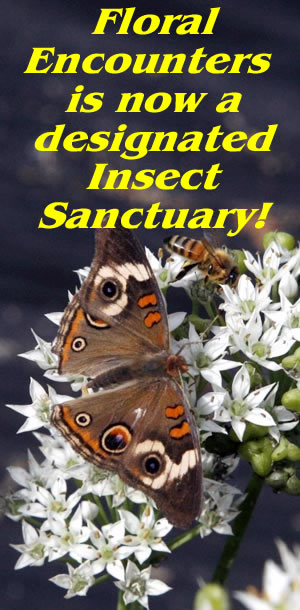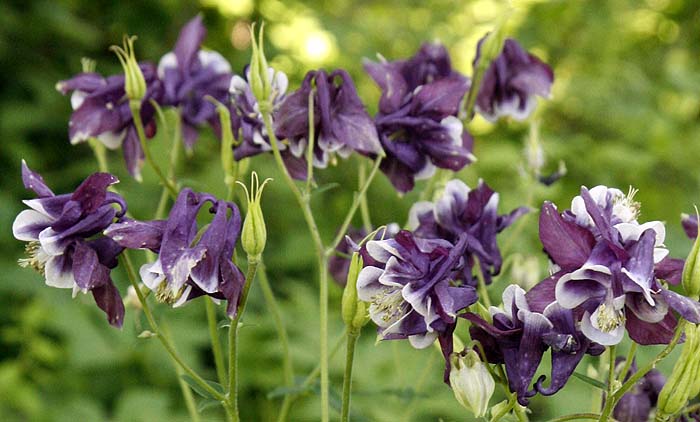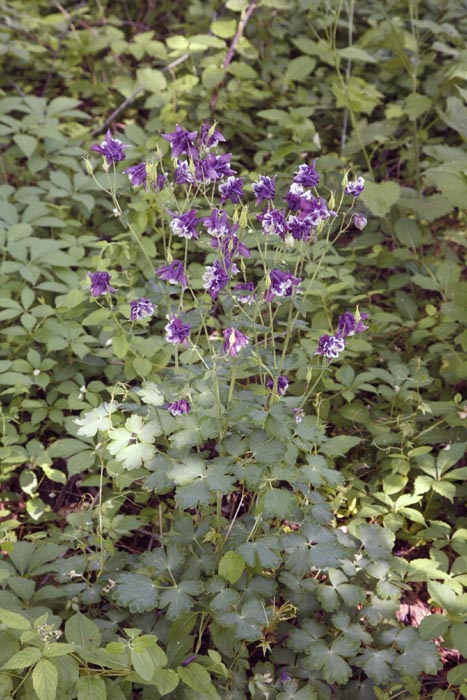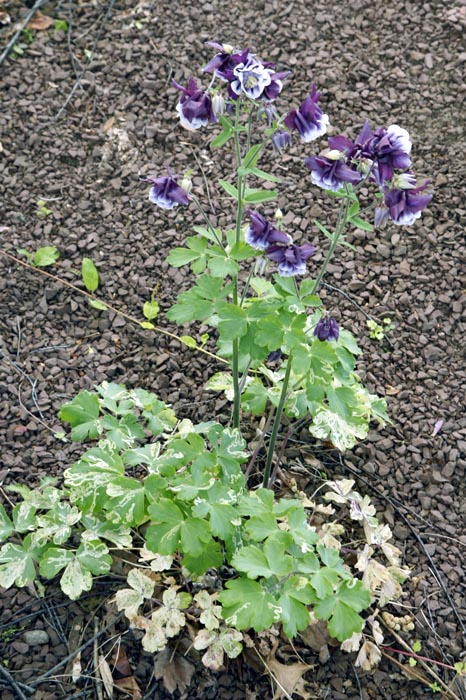Delightful delicate flower for shady areas. Blooms in mid to late spring and needs very little attention. A short lived perennial that will happily self seed itself and grow almost anywhere there is a little shade even on gravel! Has a long taproot and does not take well to transplanting, sow and forget, just enjoy the flowers. Will usually flower in the second year from seed as it needs to build its taproot first.
Description of Columbine (Aquilegia spp.)
Plant produces a tuft of bluish green leaves with long stems. Each leaf has three leaflets each on long stalks. Each leaflet stalk again has three shorter stalked leaflets which are usually three lobed but may have only two lobes and the terminal leaflet may be fused into one leaf. All leaves have lightly scalloped edges. Basal leaves (the ones at the bottom) are the largest and can be 10 inches across the whole leaf. In spring the plant produces one or more flower stems which have leaves on the lower edges. These leaves will be smaller than the basal leaves. The flower stem can grow up to two feet in height, it is erect, slender and pliable. The stems branch as they reach their full height and produce a loose cluster of flower heads one at the end of each stem. The flowers are usually blue in color but can also be light pink with five outer petals ovoid shaped sepals and five inner petals that are more rounded and often white or lighter blue in color. The petals usually have a spur pointing backwards out the back of the flowers. Most often the heads are slightly drooping. The flowers are followed by small cylindrical seed pods with pointed ends that shed seeds when the winds blow.
What variety?
Columbines tend to hybridize easily with any others of any species in the area so it is very hard to keep a variety true once seeding begins. Thus we don't specify a particular species or variety for our seed. Since all the flowers produced are lovely we just enjoy the blooms.
Growing Columbine (Aquilegia spp.) from seed.
Directly sowing where the plants are intended to grow is often the best choice. Sow in early spring or late fall for flowering plants the following year. If growing indoors start in late winter in cool environment, a window ledge or cold greenhouse is ideal. Plant in individual biodegradable pots that can be planted directly to avoid disturbing the roots. Harden plants off in early spring, once settled the seedling can tolerate some minor frost providing they are at least 3 inches in height.
Most commonly columbines flower in their second year from seed but occasionally they will flower in the first year. Fall sown seed is more likely to produce flowers the first year. For more detailed information on starting seeds indoors see our General Growing Instructions.
Location and Care of Columbine (Aquilegia spp.).
Columbines are not fussy about the soil type, they will even grow in gravel provided it has some organic material mixed in. They like semi shaded to shaded areas and cannot tolerate full sunshine and do not do well in hot climates, if growing below zone 7 extra care will be needed to shade and keep the plants cool in the summer. They will grow very well in areas that have morning or afternoon sun but not midday sunshine. They are an excellent choice for woodland gardens or on the north side of buildings. Columbines don't need a lot of water once established and are fairly drought tolerant but will need some extra watering if the hot summers are particularly dry. The amount of water they need will depend on their location. For those in gravel more water will be needed than those in good loam which holds water fairly well. They cannot tolerate wet feet and will not grow in waterlogged soils.Columbines have a long taproot which is the reason they are so tolerant of low water but it makes them very hard to transplant. Plant where they are intended to stay. If transplanting is necessary do so in the early spring when the leaves are just forming. Dig deeply and remove the whole tap root. Replant disturbing the root as little as possible. Water daily until the plant has established. Often plants will not tolerate being moved but often with lots of water they will gradually recover and grow. Columbine plants usually survive for at least 2-3 years but then most often die. However they will self seed themselves very easily so more plants take their place. The plants are hardy to zone 3.
Deadheading can increase the number of blooms produces. Once the flowering has finished cut down flower stems and remove some of the old leaves to rejuvenate the plants with fresh green leaves.
Pests and diseases of Columbine (Aquilegia spp.).
The pest most commonly seen is leaf miner which tunnel through the center of the leaves leaving patterns and pathways in side the leaf. Many consider this to be unsightly to the foliage, although the miners can be controlled by pesticides it is better to cut the leaves off when the plants have finished flowering and allow new ones to grow. By this time the miners have completed their cycle and the new leafs are miner free.Powdery mildew can attack the plants in hot dry summers.
Culinary Uses of Columbine (Aquilegia spp.).
Flowers are edible they have a sweet taste due to the richness of their nectar and make an lovely addition to salads in both color and sweetness.
Medicinal uses of Columbine (Aquilegia spp.)
No longer commonly used in herbal medicine columbine leaves and flowers were once used to help remove parasites and as an Antispasmodic. The seed was chewed, or an infusion of the root was used, to treat abdominal pains. The seeds were also used ground up as a paste to remove hair of lice.








